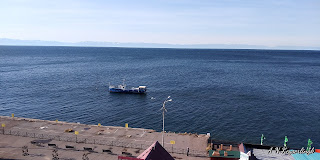Chapter 7 Novosibirsk, Russia. September 2019.
 |
| Statue of a mouse in Novosibirsk Science park representing the contribution of mice to Science. |
We arrived in Novosibirsk the morning from our overnight trip out of Kazan. Our hotel rooms were not available so our new guide Natalia scooped us up and we set off to visit the large outdoor railroad museum and the Novosibirsk Science City which are both about 30 km out of town. We got into a lovely traffic jam which delayed our arrivals but we had a loose schedule.
Pictures of Novosibirsk can be seen at:
https://photos.app.goo.gl/xESh2siGW9xnXHCy6
The outdoor railroad museum is huge and has some 200 cars and engines on display. We visited various cars including the car used by the Tsar when he traveled. Not really that impressive except that it was fully bulletproof. But it did drive home how important the railway is and was in the development of Russia.
 |
| The Novosibirsk outdoors train museum |
 |
| Inside the Tsar's rail car. |
The Novosibirsk Science City is unique in that Krustchev wanted a city where scientists from all branches of science would work. It was a closed area for a long time but now is open to visitors. The campus of the local university is also on these grounds which assures a ready supply of young engineers and scientists who carry on that work. One of the interesting things on the campus of the Science city is a statue showing a mouse. It recognizes the important contribution that mice made and are making to further science.
 |
| Monique showing our guide Natalia pictures of earlier visits. |
After a nice long lunch on the campus of the science city, we headed back to Novosibirsk to visit older parts of this former frontier city. We viewed the local ballet and musical theatre which, until recently had been the biggest in the world. Apparently, Argentina now holds that title. It was built in the time of Stalin and would have served as Stalin's headquarters if he had ever been forced to leave Moscow.
We walked through the local market and marveled at the different foods. One can definitively see that the faces of the people are starting to become more and more Asian as we move west.
During the afternoon, we visited a strange little museum showing art done using Birch bark. Birches in this region represent at least 40% of the forests although they tend to be small in diameter. The local tribes used the bark for various storage needs but did not use it to build canoes as was done in North America.
Our guide in Novosibirsk, Natalia was really a wonderful guide and a charming person. Monique and Natalia got along like long lost friends with Monique showing Natalia vast numbers of pictures of our travels over a 3-hour lunch. We left that evening and were sad to say goodbye to our new friend.
We boarded our train for a 22-hour ride to Krasnoyarsk.











Comments
Post a Comment